#24th panzer division
Text
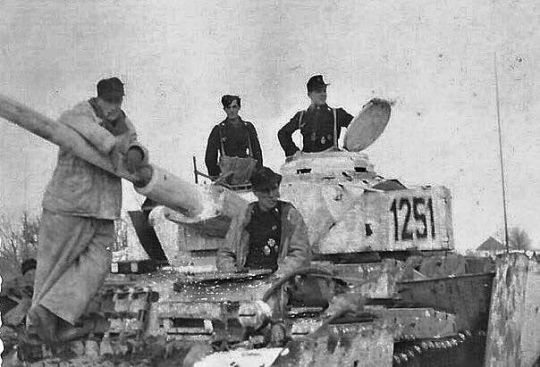
Equipage d'un panzer IV Ausf. H n° 1251 de la 24e Panzerdivision – Offensive Nikopol-Krivoi Rog (partie de l'offensive Dniepr-Carpates) – Nikopol – Union soviétique – Janvier-février 1944
#WWII#front est#eastern front#offensive dniepr-carpates#dnieper–carpathian offensive#nikopol–krivoi rog offensive#offensive nikopol-krivol rog#armée allemande#german army#wehrmacht#heer#24e panzerdivision#24th panzer division#nikopol#union soviétique#soviet union#urss#ussr#01/1944#02/1944#1944
37 notes
·
View notes
Text

German tanks of the 24th Panzer Division advance into the outskirts of Stalingrad - Sept 1942
#world war two#1940s#worldwar2photos#history#ww2#ww2 history#wwii#wwii era#ww2history#world war 2#stalingrad#eastern front#soviet union#1942#panzer#panzers#wehrmacht
65 notes
·
View notes
Text
The Battle of Stalingrad in pictures.

Soviet soldiers in action in 1942 during the battle

German soldiers in the steppe with the support of a StuG III

Two non-commissioned officers of the 24th Panzer Division in action in the area of the southern station of Stalingrad on 15 September 1942.

Soviet soldiers during the clashes in the city.

Soviet T-34 tank crews prepare for Operation Uranus
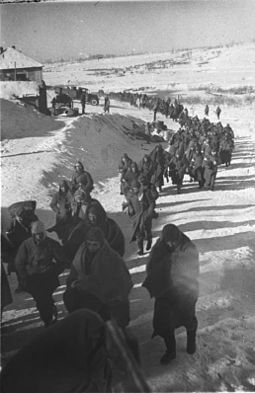
German prisoners marching in the snow towards the collection camps in the rear
The term ''Battle of Stalingrad'' refers to the hard fighting that took place during the Second World War which, between the summer of 1942 and 2 February 1943, pitted the soldiers of the Red Army against the German, Italian, Romanian and Hungarians for control of the strategic region between the Don and the Volga and the important political and economic center of Stalingrad (now Volgograd), on the eastern front.
Sources:
Wikipedia: Battle of Stalingrad
Military Wiki: Battle of Stalingrad
I DON'T SUPPORT NAZISM,FASCISM OR ZIONISM IN ANY WAY, THIS IS JUST AN EDUCATIONAL POST
27 notes
·
View notes
Text
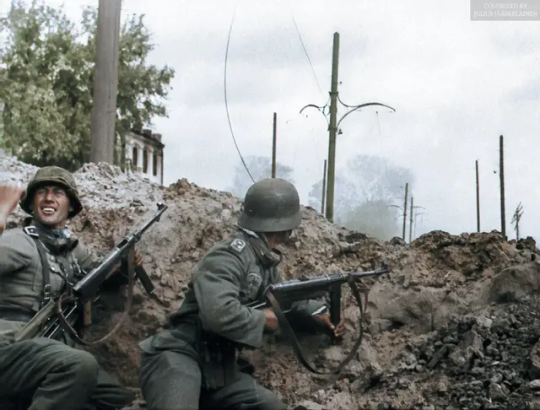
German soldiers of the 24th Panzer Division during the fighting for the southern station of Stalingrad, 15 September 1942.
12 notes
·
View notes
Text
NATO's Nazi Background
Literally, Hitler's Chief of Staff Adolf Heusinger became the Chairman of the Military Committee for NATO from 1961-1964
Then there's one of Hitler's most infamous German Field Martials Erwin Rommel's Chief of Staff, General Hans Speidel became the Supreme Commander of NATO's Ground Forces in Central Europe from 1957-1963.
And then again from 1971 to 1975 a notorious Luftwaffe Fighter Pilot who even earned the Knights Cross of the Iron Cross, one of Nazi Germany's highest medals of honor, named Johannes Steinhoff became Chairman of NATO's Military Committee.
As if THAT wasn't enough, Johann Von Keilmansegg, who was a General Staff Officer to the High Command of the Wermacht, occupied the position of Commander in Chief of Allied Forces Central Europe from 1967-1968.
A Major in the Wermacht and Group Leader of the Organizational Department of the Supreme Command of the Wermacht from 1943-1945 and a recipient of the Iron Cross named Ernst Ferber was NATO's Commander in Chief of Allied Forces 1973-1975
And NATO's Commander in Chief of Allied Forces Central Europe from 1977-1979 was Franz Joseph Schulze who was a Lieutenant in the reserve and Chief of the 3rd Battery of the Flak Storm Regiment 241 and became a recipient of the Knights Cross of the Iron Cross in 1944.
Another Nazi, Ferdinand von Senger und Etterlin who was a Lieutenant in the 24th Panzer Division in the German 6th Army, a participant in the Battle of Stalingrad, adjutant to Army High Command, of course became NATO's Supreme Commander of Allied Forces Central Europe from 1979 to 1983.
So to make this perfectly clear; the United States who led the creation of NATO with its Allied partners the UK and France, instead of capturing, imprisoning and prosecuting in a War Crimes Tribunal like the Nuremberg Trials this list of Nazi War Criminals, these Western Imperialist Powers chose to put these Nazis in charge of NATO and its Armed Forces.
If you think the NATO of today is any different; that it wouldn't ally itself with Nazis today, like in Ukraine, then you are sorely mistaken.
Here's a couple of links if you have any doubts
Adding this pic:

#nato#nato and nazis#nazis in nato#nato imperialism#nato news#nato facts#us imperialism#imperialism#western imperialism#capitalism#capitalist imperialism#neoliberalism#neoliberal capitalism#socialism#communism#marxism leninism#socialist politics#socialist news#socialist worker#socialist#communist#marxism#marxist leninist#progressive politics#politics#ukraine war#nazis in ukraine#ukrainian nazis#ukraine proxy war#us hegemony
28 notes
·
View notes
Photo
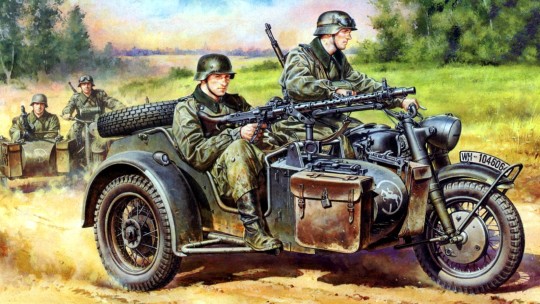
1942 German motorcycle BMW R75, 24th Panzer Division, Eastern Front, 1942.
11 notes
·
View notes
Photo

German Panzer III of the 24th Panzer Division of the Wehrmacht in the suburbs of Stalingrad
9 notes
·
View notes
Text
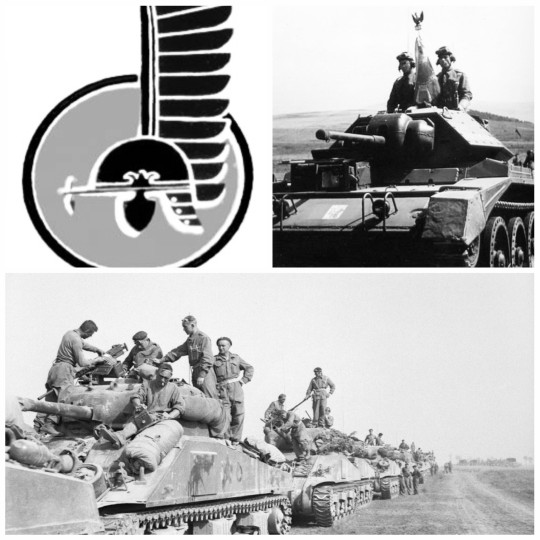
• Polish 1st Armoured Division
The Polish 1st Armoured Division was an armoured division formed as part of the Polish Armed Forces in the West during World War II.
After the fall of Poland and then France in 1940, the remaining Poles that had fought in both campaigns retreated with the British Army to the United Kingdom. Stationed in Scotland the Polish 1st Armoured Division was formed as part of the Polish I Corps under Wladyslaw Sikorski, which guarded approximately 200 kilometres of British coast in 1940-1941. The commander of the Division, General Stanislaw Maczek, was Poland’s premier mechanized commander, and many of his subordinate officers from the unit he commanded in 1939, the 10th Mechanized Brigade, had made their way to Britain with him. They were organized on the British Armoured Division model, equipped with British uniforms, weapons and tanks. They were initially equipped and trained on Crusader tanks but in late 1943 and early 1944 these were replaced with Sherman tanks and Cromwell tanks.
By the end of July 1944, the 1st Armoured had been transferred to Normandy, its final elements arriving on August 1st. The unit was attached to the First Canadian Army as part of the 21st Army Group. This may have been done to help in communication, as the vast majority of Poles did not speak English when they arrived in United Kingdom from 1940 onwards. The Division joined combat on August 8th, during Operation Totalize. It suffered serious casualties as a result of "friendly fire" from Allied aircraft, but achieved a victory against the Wehrmacht in the battles for Mont Ormel, and the town of Chambois. This series of offensive and defensive operations came to be known as the Battle of Falaise, in which a large number of German Army and SS divisions were trapped in the Falaise Pocket and subsequently destroyed. Maczek's division had the crucial role of closing the pocket at the escape route of the trapped German divisions, hence the fighting was desperate and the 2nd Polish Armoured Regiment, 24th Polish Lancers and 10th Dragoons, supported by the 8th and 9th Infantry Battalions, took the brunt of German attacks by units attempting to break free from the pocket. Surrounded and running out of ammunition, they withstood incessant attacks from multiple fleeing panzer divisions for 48 hours until they were relieved. The total losses of the division from August 7th when it entered combat until the end of the battle of Falaise on August 22nd were 446 killed, 1501 wounded, and 150 missing, or 2097 soldiers in total during about two weeks of fighting.
After the Allied armies broke out from Normandy, the Polish 1st Armoured Division pursued the Germans along the coast of the English Channel. It liberated, among others, the towns of Saint-Omer, Ypres, Oostnieuwkerke, Roeselare, Tielt, Ruislede, and Ghent. During Operation Pheasant a successful outflanking manoeuvre planned and performed by General Maczek allowed the liberation of the city of Breda without any civilian casualties. The Division spent the winter of 1944-1945 on the south bank of the river Rhine, guarding a sector around Moerdijk, Netherlands. In early 1945, it was transferred to the province of Overijssel and started to push with the Allies along the Dutch-German border, liberating the eastern parts of the provinces of Drenthe and Groningen including the towns of Emmen, Coevorden and Stadskanaal.
In April 1945, the 1st Armoured entered Germany in the area of Emsland. On May 6th, the Division seized the Kriegsmarine naval base in Wilhelmshaven, where General Maczek accepted the capitulation of the fortress, naval base, East Frisian Fleet and more than 10 infantry divisions. There the Division ended the war and, joined by the Polish 1st Independent Parachute Brigade, undertook occupation duties until it was disbanded in 1947; it, together with the many Polish displaced persons in the Western occupied territories, formed a Polish enclave at Haren in Germany, which was for a while known as "Maczków". The majority of its soldiers opted not to return to Poland, which fell under Soviet occupation, preferring instead to remain in exile. Many artefacts and memorabilia belonging to Maczek and the 1st Polish Armoured Division are on display in the Polish Institute and Sikorski Museum in London.
#second world war#world war 2#world war ii#military history#wwii#history#british history#polish history#tank history#tank warfare#tanks#battle of normandy
168 notes
·
View notes
Photo
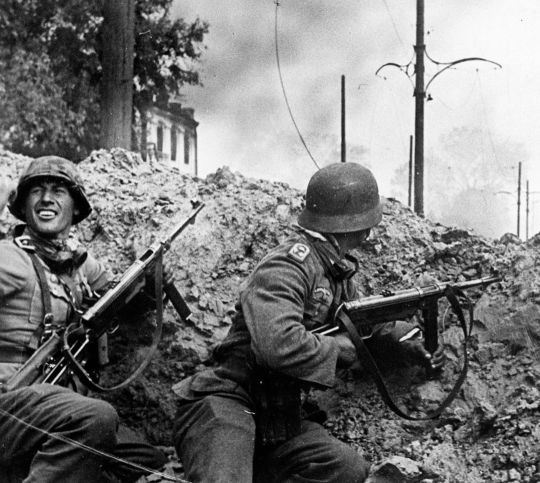
German soldiers of the 24th Panzer Division in action during the fighting for the southern station of Stalingrad. Sept 15, 1942. [Berliner Illustrierte Zeitung 1 ottobre 1942 / Photo by: Geller] https://www.instagram.com/p/CGXRSNgpED4/?igshid=18tegcapv7nys
27 notes
·
View notes
Text
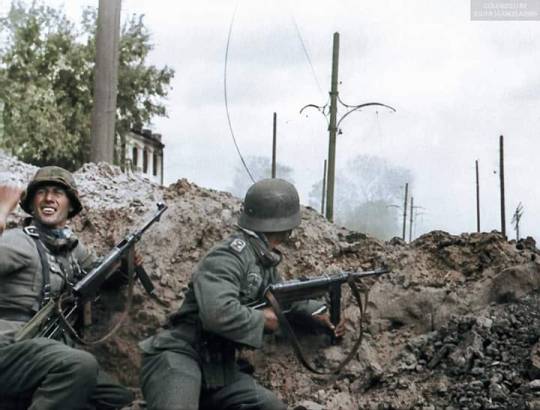
Tentara Jerman 24th Panzer Division, mempertahankan posisi di selatan Stasiun Stalingrad 15 September 1942.
2 notes
·
View notes
Video
Panzer III Ausf.L ‘K1615 / 7’ by Alan Wilson
Via Flickr:
German WW2 era Medium Tank Official designation:- Sd.Kfz.141 Panzerkampfwagen III Built:- 1939-1943. Total production:- 5774. Main armament:- 5cm KwK 39 L/60 tank gun. This is an early production Ausf L, modified for ‘tropical’ use and built by MAN in June 1942. It was sent by rail direct from Nürnberg to Naples and was then shipped aboard the SS Lerica to Benghazi, arriving on 18th July 1942. There it was issued to 7 Kompanie 8th Panzer Regiment, 15th Panzer Division, and probably fought at Alam Halfa. After capture it was shipped to the School of Tank Technology at Chobham Lane, Chertsey, Surrey, before being moved to Bovington. It was put on the museum books in 1951. Now restored to running order and painted in its original markings, it is a regular performer in the Kuwait Arena and is seen during TankFest 2017. ‘The Tank Museum’, Bovington Camp, Dorset, UK. 24th June 2017
2 notes
·
View notes
Photo
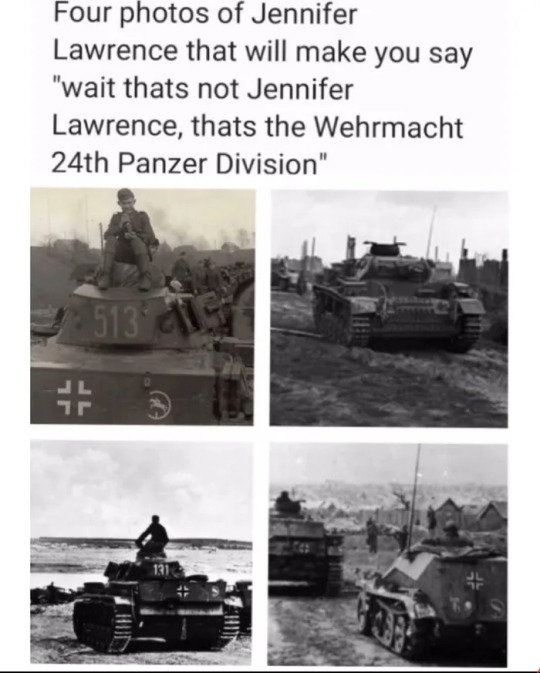
Wait, thats not Jennifer Lawrence, thats the Wehrmacht 24th Panzer Division
0 notes
Photo

Soldier of German 24th Panzer Division sleeping on the sidecar of a R75 motorcycle, southern Russia, summer 1942. Credit: Bundesarchiv, Bild 101I-217-0499-18, Sautter. http://wrhstol.com/2nkxRXf
59 notes
·
View notes
Text
ON TARGET: Holocaust Horrors Must Never Be Forgotten
By Scott Taylor
Just prior to the January 29 International Holocaust Remembrance Day commemorations, a shocking study was released which revealed that nearly half of Canadian’s cannot name a single Nazi concentration camp.
Commissioned by the Azrieli foundation and conducted by Schoen consulting, the study was based on over 1,100 interviews of randomly selected individuals to reflect Canada’s diverse demographics.
According to the findings, millennials or those adults aged 18 aged 34 were the most un-informed regarding even the basic details of Hitler’s Holocaust.
In their January 24th story about this study, the New York Times noted that when Canada inaugurated its first National Holocaust Memorial in Ottawa in 2017, the plaque somehow omitted any mention of Jews or anti-Semitism. Following public outrage, that plaque has since been replaced with one more accurately reflecting the victims of the Holocaust.
It is this ignorance of the horrors of the Holocaust that is allowing for a rise in neo-Nazism across Canada. It is estimated that there are currently as many as 300 such hate based groups operating in our country.
In mid-January, Public Safety Minister Ralph Goodale issued an appeal to high-tech firms to aid authorities in halting the online activities of these right wing, anti-Semitic factions.
Ignorance of the Holocaust is also allowing for many deniers to re-write history, a trend which is taking place in many European countries, often with official sanction.
One refreshing counter to this deliberate historical revision came out last week in the form of an official announcement by the Government of Finland. After an appeal to Finland’s President by an Israeli historian, a study was conducted to examine the role of Finnish volunteers in the Nazi Waffen SS during WWII.
The recently published results conclude that the 1,408 Finns who volunteered and fought as part of the 5th Panzer Division Wiking were indeed implicated in the slaughter of Jews, thus making them perpetrators of the Holocaust. This was a brave move by the Finnish Government, as these wartime SS volunteers had previously only been considered frontline soldiers, albeit allied with Adolf Hitler.
In stark contrast to the Finnish position, is that of the Ukrainian government’s celebration of Stepan Bandera. During WWII, Bandera was a Nazi collaborator who’s Organization of Ukrainian Nationalists (OUN) participated in the mass execution of thousands of Jews in 1941. Bandera later fought against both the Germans and the Soviets in his quest for an independent Ukraine. He is now being revered for his efforts to create a nation, with streets named after him, his birthday declared a national holiday, and in his hometown of Lvov, 2019 has been declared the ‘Year of Stepan Bandera.’
In a recent scuffle between Ukrainian police and right-wing demonstrators in Kiev, one officer was caught on video shouting “On the ground, Banderite!” as he apprehended a rioter. Banderite is the name used to describe Bandera’s followers. The policeman’s use of the term as a derogatory slur caused an angry backlash across western Ukraine. In response the police chief announced that the officer in question would be disciplined, and then proclaimed himself to be a Banderite. This prompted the Minister of the Interior to follow suit and also proclaim his public support for Bandera.
Whatever Bandera did for Ukrainian nationhood cannot be allowed to erase the fact that he was a rabid anti-Semite who slaughtered Jews. Canada currently has approximately 200 military trainers based in Ukraine and according to the stated rationale for our military assistance is to help Ukraine defend our common values from Russian aggression.
Surely that does not allow us to turn a blind eye to such very public celebrations of a man who slaughtered Jews?
Similarly, we have over 500 combat soldiers based in Latvia and next month, on March 16, there will be a parade to honour those Latvians who fought in Hitler’s SS Latvian Legion.
A group known as the Arajs Commando formed the core element of this SS Unit. The Arajs Commando is credited with exterminating the Jewish population of Latvia to such an extent that by 1942 SS leader Heinrich Himmler pronounced the country “Juden frei” (Jew free).
As that recent study clearly shows, far too many Canadians know far too little about the Holocaust. How else can one explain allowing our allies to stage parades and name streets after perpetrators of the worst crime ever committed against humanity?
0 notes
Photo

Stalingrad Bundesregierung relativiert Vernichtungskrieg gegen Sowjetunion und … is Trending on Thursday January 25 2018 http://www.aioinstagram.com/stalingrad-bundesregierung-relativiert-vernichtungskrieg-gegen-sowjetunion-und-is-trending-on-thursday-january-25-2018/
RT Deutsch says: Bundesregierung relativiert Vernichtungskrieg gegen Sowjetunion und …
Top 1 articles about Stalingrad:
Bundesregierung relativiert Vernichtungskrieg gegen Sowjetunion und verweigert Stalingrad-Gedenken. 25.01.2018 • 15:07 Uhr. https://de.rt.com/1dhu. Bundesregierung relativiert Vernichtungskrieg gegen Sowjetunion und verweigert Stalingrad-Gedenken
Trending Images of Stalingrad on Instagram:
This Stalingrad’s photo Trending 1 on Instagram, Photo credit to Instagram
Description: ☭25 ЯНВАРЯ, 1943 год /понедельник/ За период проведения операции «Кольцо» с 10 по 25 января насчитывалось свыше 100 тысяч убитых, раненых и пленных гитлеровцев. Территория, занимаемая противником, сократилась до 100 км. Ее протяженность с севера на юг составляла 20 км, а с запада на восток — всего 3,5 км. Войска Донского фронта подошли к юго-западной и западной окраинам Сталинграда, уничтожая противника на улицах города ⠀ January 25, 1943 /Monday/ During the period of carrying out the operation «Ring» from 10th to 25th January there were over 100 thousand of killed, injured and imprisoned Hitler’s warriors. The territory, occupied by the adversary, shortened to 100 km ⠀ #хроникаСталинградскойбитвы #200огненныхдней #сталинградскаябитва #сталинград #контрнаступление #сталинград75 #сталинградскаябитва75 #сталинградская_битва #операциякольцо #stalingrad #stalingradbattle #WWII
This Stalingrad’s photo Trending 2 on Instagram, Photo credit to Instagram
Description: Capitaine Friedrich Winkler durant la bataille de Stalingrad . Il est connu pour ses faits d’armes avec son PPSH-41 #ww2#german#stalingrad#hell#ppsh
This Stalingrad’s photo Trending 3 on Instagram, Photo credit to Instagram
Description: A soldier of the red army near German reconnaissance aircraft Focke-Wulf Fw.189. The Stalingrad region, 1943. #ww2 #history #war #stalingrad
This Stalingrad’s photo Trending 4 on Instagram, Photo credit to Instagram
Description: ☭24 ЯНВАРЯ, 1943 год /воскресенье/ Генерал-полковник Ф. Паулюс докладывает по радио в Ставку о практически полном отсутствии в войсках боеприпасов и продовольствия, о невозможности единого управления войсками. Паулюс просит дать разрешение на капитуляцию. На следующий день Гитлер отклонил просьбу 6-й полевой армии вермахта о капитуляции и потребовал сражаться до последнего патрона ⠀ January 24, 1943 /Sunday/ General-colonel F. Paulus reports by radio to the Headquarters of practically full absence of ammunition and food in armies and impossibility of unified control of the armies. Paulus asks to give permission for the capitulation. The next day Hitler declined the entreaty of 6th field army of Wehrmacht of capitulation and requested to fight till there wouldn’t be a single cartridge left ⠀ #хроникаСталинградскойбитвы #200огненныхдней #сталинградскаябитва #сталинград #контрнаступление #сталинград75 #сталинградскаябитва75 #сталинградская_битва #операциякольцо #stalingrad #stalingradbattle #WWII
This Stalingrad’s photo Trending 5 on Instagram, Photo credit to Instagram
Description: ☭20 ЯНВАРЯ, 1943 год /среда/ Генерал-полковник Ф. Паулюс обратился к командованию группы армий и главному командованию сухопутных сил вермахта с донесениями об ухудшении положения вверенных ему войск вследствие катастрофического положения с продовольствием, горючим и боеприпасами. Ответ главного командования ограничивал свободу действий генерал-полковника Ф. Паулюса и запрещал капитуляцию ⠀ January 20, 19743 /Wednesday/ General-colonel F. Paulus has addressed the command of the group of armies and the main command of land forces with reports on worsening of German-fascist armies’ position as a result of catastrophic situation with food, fuel and ammunition. Supreme command’s response limited the freedom of actions of general-colonel F. Paulus and prohibited capitulation ⠀ #хроникаСталинградскойбитвы #200огненныхдней #сталинградскаябитва #сталинград #контрнаступление #сталинград75 #сталинградскаябитва75 #сталинградская_битва #операциякольцо #stalingrad #stalingradbattle #WWII
This Stalingrad’s photo Trending 6 on Instagram, Photo credit to Instagram
Description: German soldiers of the 24th Panzer Division in action during the fighting for the southern station of Stalingrad. 15/09/1942 #colored #colorized #colourised #color #colour #history #ww2 #wwii #worldwartwo #military #war #russia #allies #helmet #germany #easternfront #fighting #Stalingrad #troops #infantry #machinepistols
This Stalingrad’s photo Trending 7 on Instagram, Photo credit to Instagram
Description: Two German soldiers observe a Soviet artillery position in Stalingrad, 1942. #colored #colorized #colourised #colorization #colourisation #color #colour #restoration #repair #history #military #ww1 #wwi #worldwarone #greatwar #thegreatwar #ww2 #wwii #worldwartwo #military #war #warfare #allies #axis #wehrmacht #soviet #stalingrad
This Stalingrad’s photo Trending 8 on Instagram, Photo credit to Instagram
Description: Смерть Сталина, которую мы заслужили. … #смертьСталина #deathcore #stalingrad #haiphong
This Stalingrad’s photo Trending 9 on Instagram, Photo credit to Instagram
Description: Le beau temps commence à manquer

..


. . . . . #france #bordeaux #stalingrad #pontdepierre #bordeauxmaville #europe #bordeauxcity #bridge #pont #skyporn #bridgeporn #ciel #colorful #beautifulsky #sunset #sunsetlovers #garonne #garonneriver #photography #instavisit #likeatourist #instagood #wanderlust #travelgram #instatravel #thisview #bestview #instaview

0 notes
Text

• Battle of the Bzura
The Battle of the Bzura (or the Battle of Kutno) was the largest battle of the 1939 German invasion of Poland, fought, between Polish and German forces.
The Polish plan for defense against the German invasion, Plan West, called for the defense of the borders. This was dictated more by political than military concerns, as Poles feared that the Germans, after taking over territories they lost in the Treaty of Versailles, would try to end the war and keep those territories. While defending the borders was riskier, the Poles were counting on the British and French counteroffensive (that never came). Due to this, Army Pomorze under general Władysław Bortnowski found itself in the Polish Corridor, surrounded by German forces on two fronts, and Army Poznań under general Tadeusz Kutrzeba was pushed to the westernmost fringes of the Second Polish Republic, separated both from its primary defensive positions, and from other Polish Armies. The German offensive proved the folly of the border defense plan in the first days of the war. Army Pomorze was defeated in the battle of Bory Tucholskie, and forced to retreat towards the south-east. Army Poznań, meanwhile, although not facing heavy German assaults, was forced to retreat east due to defeats of its neighbours. meaning that Army Poznań was in danger of being flanked and surrounded by the German forces. On September 4th, Army Poznań moved through Poznań and abandoned it to the enemy, although at this point it was not in contact with any significant German forces. By September 6th, Armies Pomorze and Poznań had linked, forming the strongest Polish operational unit in the campaign, and general Bortkowski accepted the command of general Kutrzeba.
On September 7th, Polish forces became aware of the German push towards Łęczyca, which if successful could cut off the retreat route of Polish forces. By September 8th, advanced German troops reached Warsaw, marking the beginning of the siege of Warsaw in 1939. At the same time, German forces had lost contact with Army Poznań, and German command assumed that the army must have been transported by rail to aid Warsaw's defense; they were unaware that in fact Army Poznań had merged forces with Army Pomorze, which they considered, since its defeat at Bory Tucholskie, no longer a significant threat.
Polish forces consisted of Army Poznań and Army Pomorze. German forces included the 8th Army under Johannes Blaskowitz and 10th Army under Walther von Reichenau of Army Group South, elements of the 4th Army under Günther von Kluge of the Army Group North and air support (Luftflotte 1 and Luftflotte 4). The battle can be divided into 3 phases: Phase I, Polish offensive towards Stryków, aiming at the flank of the German 10th Army, Phase II, Polish offensive towards Łowicz, Phase III, German counterattack and eventual defeat of the Poles, with the latter's withdrawal towards Warsaw and Modlin. On the night of September 9th, the Polish Poznań Army commenced a counterattack from the south of the Bzura river, its target being the German forces from the 8th Army advancing between Łęczyca and Łowicz, towards Stryków. The commander of Poznań Army, Tadeusz Kutrzeba noticed that the German 8th Army, was weakly secured from the north by only the 30th Infantry Division stretched over a 30 kilometre defensive line while the rest of the army was advancing towards Warsaw. The main thrust of the Polish offensive were the units under general Edmund Knoll-Kownacki, known as the Knoll-Kownacki Operational Group. The right wing of the offensive, in the area Łęczyce, included the Podolska Cavalry Brigade under Col. L. Strzelecki, and on the left, advancing from Łowicz to the area of Głowno, the Wielkopolska Cavalry Brigade under general Roman Abraham. These groups inflicted considerable losses on the German defenders from the 30th Infantry Division and the 24th Infantry Division, with some 1,500 German soldiers killed or wounded and an additional 3,000 lost as prisoners during the initial push. The cavalry brigades supplemented with TKS and TK-3 reconnaissance tanks moved to threaten the flanks and rear of the advancing German units.
The German forces were thrown back approximately 20 kilometres and the Poles recaptured several towns, including Łęczyca and Piątek, and the village of Góra Świętej Małgorzaty. On September 10th, the Polish 17th Infantry Division met the German 17th Infantry Division at Małachowicze. The following day Polish forces continued their attack, advancing on Modlna, Pludwiny, Osse and Głowno. Initially underestimating the Polish advance, the Germans decided on September 11th, to redirect the main force of the German 10th Army, the German 4th Army, the reserves of the Army Group South, and aircraft from 4th Air Fleet towards the Bzura. These forces included the German 1st Panzer Division, German 4th Panzer Division and the newly formed SS Infantry regiment Leibstandarte Adolf Hitler. German air superiority had a significant impact, making it very costly and difficult for the Poles to move units during the day. The following day the Poles reached the line Stryków-Ozorków. That day General Tadeusz Kutrzeba learned that units of Army Łódź had retreated to the Modlin Fortress, and decided to stop the offensive, instead looking to try to break through Sochaczew and the Kampinos Forest to reach Warsaw. On the morning of September 14th, General Władysław Bortnowski's 26th and 16th Infantry Divisions crossed the Bzura near Łowicz. The Polish 4th Infantry Division reached the road linking Łowicz with Głowno. At this point however, Bortnowski ordered the 26th Infantry Division to retreat. He had learned of the withdrawal of the German 4th Panzer Division from the outskirts of Warsaw, and was concerned that this Panzer division posed a threat to his men.
On the 15th and 16th September, Army Pomorze took up defensive positions on the north bank of the Bzura. General Stanisław Grzmot-Skotnicki's group was between Kutno and Żychlin, General Michał Karaszewicz-Tokarzewski's units near Gąbin, and parts of Army Poznań by the Bzura near Sochaczew, were ready to begin their drive towards Warsaw. To encircle and destroy the Polish forces, the Germans used most of their 10th Army, including two armoured, one motorized, and three light divisions, equipped with some 800 tanks altogether. The attack from all sides on Polish positions started on September 16th, with the support of the Luftwaffe. On September 15th, Poles were forced out of Sochaczew, a town on the Bzura river, and trapped in a triangle of Bzura, Vistula and German forces. The German 1st Panzer Division, after crossing the Bzura between Sochaczew and Brochów and engaging the Polish 25th Infantry Division managed to capture Ruszki, but its advance was then halted. Poles began to cross the Bzura near the Vistula, north of Sochaczew, and retreat towards Warsaw. Polish forces were forced to abandon most of their heavy equipment while crossing the river. On September 17th, German heavy artillery was shelling the crossing north of Brochów, and the largest air operation of the campaign began, with the Luftwaffe attacking the retreating Polish forces. During the night of September 17th, the main forces of Army Poznań attacked the German forces in order to break out of the German encirclement between Witkowice and Sochaczew. The 15th Infantry Division and Podolska Cavalry Brigade again crossed the Bzura in Witkowice. In Brochow, the 25th and 17th Infantry Divisions crossed the Bzura river. The 14th Infantry Division was concentrated in Łaziska. At the same time, Army Pomorze marched towards the villages of Osmolin, Kierozia and Osiek.
In the morning the Germans started their drive towards the south along both banks of the Bzura, supported by more than 300 aircraft and heavy artillery. German howitzers, taking advantage of their position on the high ground of the Vistula's right bank, shelled Polish positions for the entire day. And after two days of heavy fighting, with no ammunition or food rations remaining, further attempts at a breakout for the Poles became impossible. Only a few Polish units managed to break out of the encirclement. These groups entered Warsaw and Modlin, mostly around the 19th and 20th September, crossing the Kampinos Forest, and fighting German units in the area. Among them were Generals Kutrzeba, Knoll-Kowacki and Tokarzewski, two cavalry brigades (Wielkopolska and Podolska) of General Abraham, and the 15th and 25th Infantry Divisions. The remainder (4th, 14th, 17th, 26th and 27th Infantry Divisions), which didn't manage to cross the river, with General Bortnowski, capitulated between the 18th and 22nd of September. Polish casualties were estimated at 20,000 dead, including three generals. German casualties are estimated at 8,000 dead. After the battle the remaining German divisions rushed towards Warsaw and Modlin and soon encircled both. The Bzura campaign ended in defeat for the Poles but because of the initial Polish local successes the German advance on Warsaw was halted for several days. The Wehrmacht was required to divert units from its push towards Warsaw. This enabled the Polish units defending Warsaw and its environs to better organize their own long-term, but ultimately failed, defense of the capital.
#world war 2#wwii#world war ii#history#second world war#military history#german history#polish history#invasion of poland#calvary
79 notes
·
View notes
